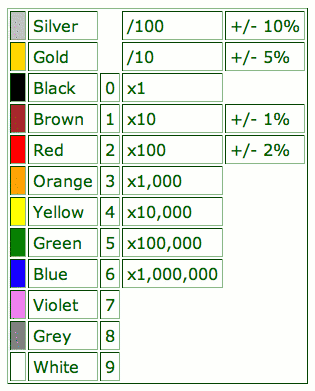Facts and Figures
|
Resistor Colour CodesResistor Colour Codesby Andy Slater
Back in the 1980's all the resistors I ever saw had a gold or silver 4th band but improvements in manufacturing have made it possible to make cheap resistors to much closer tolerances. This has caused a number of changes:
What this all means in term of component identification is this: You can't identify which is the last band by looking for the gold or silver one like we used to because it will most probably be red or brown these days and of course so could the 1st band. The way to identify that you are holding the resistor the right way round (for reading the value that is as it doesn't matter which way round it goes into the circuit) is that the spacing between the tolerance band and the others will be slightly greater than the spacing between the other bands. With 5 band resistors the first three bands give numbers with the 4th being a multiplier and the 5th being the tolerance i.e. you've now got three figure accuracy in the value of the component. This article is copyright (C) Andy Slater and is used here with permission |
|
|
Copyright (C) Webspace Ltd All rights reserved. |
||

 When I started dabbling in electronics in the early 1980's pretty much
all the resistors that we ever got our hands on were of the four band
variety. Of the four colour bands used to indicate the resistors value,
the first two gave a couple of digits. For example, if they were yellow
and violet that gave the number 47. The 3rd band was a multiplier so if
our example had a black 3rd we'd be looking at a 47 ohm (47R) resistor
while an orange band would indicate 47,000 ohms (a.k.a. 47k). The 4th
band specified tolerance. This allowed for variables in the manufacture
of the component and if, for example, our 47k resistor had a silver 4th
band the resistor could in fact be anywhere between 42,300 and 51,700
ohms!
When I started dabbling in electronics in the early 1980's pretty much
all the resistors that we ever got our hands on were of the four band
variety. Of the four colour bands used to indicate the resistors value,
the first two gave a couple of digits. For example, if they were yellow
and violet that gave the number 47. The 3rd band was a multiplier so if
our example had a black 3rd we'd be looking at a 47 ohm (47R) resistor
while an orange band would indicate 47,000 ohms (a.k.a. 47k). The 4th
band specified tolerance. This allowed for variables in the manufacture
of the component and if, for example, our 47k resistor had a silver 4th
band the resistor could in fact be anywhere between 42,300 and 51,700
ohms!